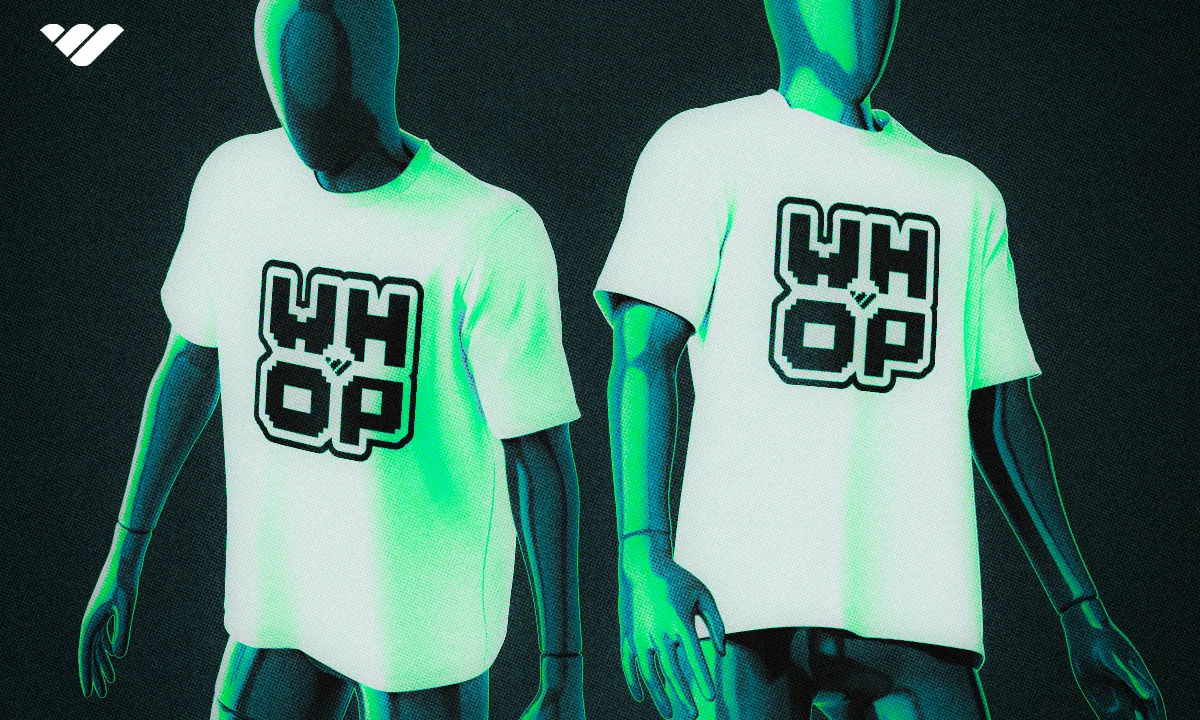Reselling and thrifting is on the rise, but is it a profitable business model? The answer is a resounding yes. Discover all you need to know about making money reselling clothes in this guide.
Key takeaways
- Choosing a specific niche aligned with your interests helps you build a loyal audience and compete more effectively.
- Cleaning, repairing, and properly presenting thrifted clothing significantly increases resale value and justifies higher prices.
- Source inventory strategically from thrift stores, garage sales, and wholesale lots to maximize profit margins.
Picking a type of item to resell is a topic that many beginner resellers struggle with, as there are countless products and markets to choose from. However, one of the best entry points that is also perhaps the most immediately accessible is clothing, which serves as the perfect fit for many resellers who build a thriving business from wearables in all categories.
In this comprehensive guide, we’ll dive into why reselling clothing is a good idea and go over the best way to go about starting a business that has the potential for scale even if you start completely from scratch with a low budget.
Why Should You Resell Clothing?
Clothing might be your best entry point into reselling for many reasons. The first reason is the immediate accessibility–you can start right now with items in your wardrobe.
Clothing is also tied with trends and fashion which have an evergreen demand for items both new and old, so you’ll always have opportunities to act upon if you specialize and pay attention to what people want and how much they’re paying for those items. This makes for a business that is consistent, which gives you the opportunity to scale and go full time.
Another excellent reason to get into this business is that it can be good for the planet if you deal with second hand goods. By extending the lifespan of clothing items, reselling used clothing promotes sustainability, encouraging consumers to reuse rather than buy new which reduces the demand on resource-intensive production.
As a result, you’ll have the satisfaction of running a business that not only generates profit but also contributes to a more environmentally conscious consumer culture.
The Thrifting Landscape in 2024
While it’s possible to build a clothing business flipping hyped, brand-new items, you should at least incorporate or put a strong amount of focus on dealing with pre-worn items that you can acquire by thrifting.
The market for used clothing, from vintage to recent second hand, has grown immensely in the past several years with a demand that may be higher than ever before in 2024, making for a landscape that is full of opportunity. A resale report has outlined that the global second hand market is set to nearly double by 2027, reaching $350 billion.
Part of this is due to increased consumer awareness about the environmental damage that buying most new clothing has, but another big part of the demand in thrifted clothes has been vintage fashion trends that have been widely spread by social media influencers. Social media has also generally displayed an increase in craving of nostalgia that can be partially satisfied with older clothing.
How Do I Make Money by Thrifting Used Clothes?
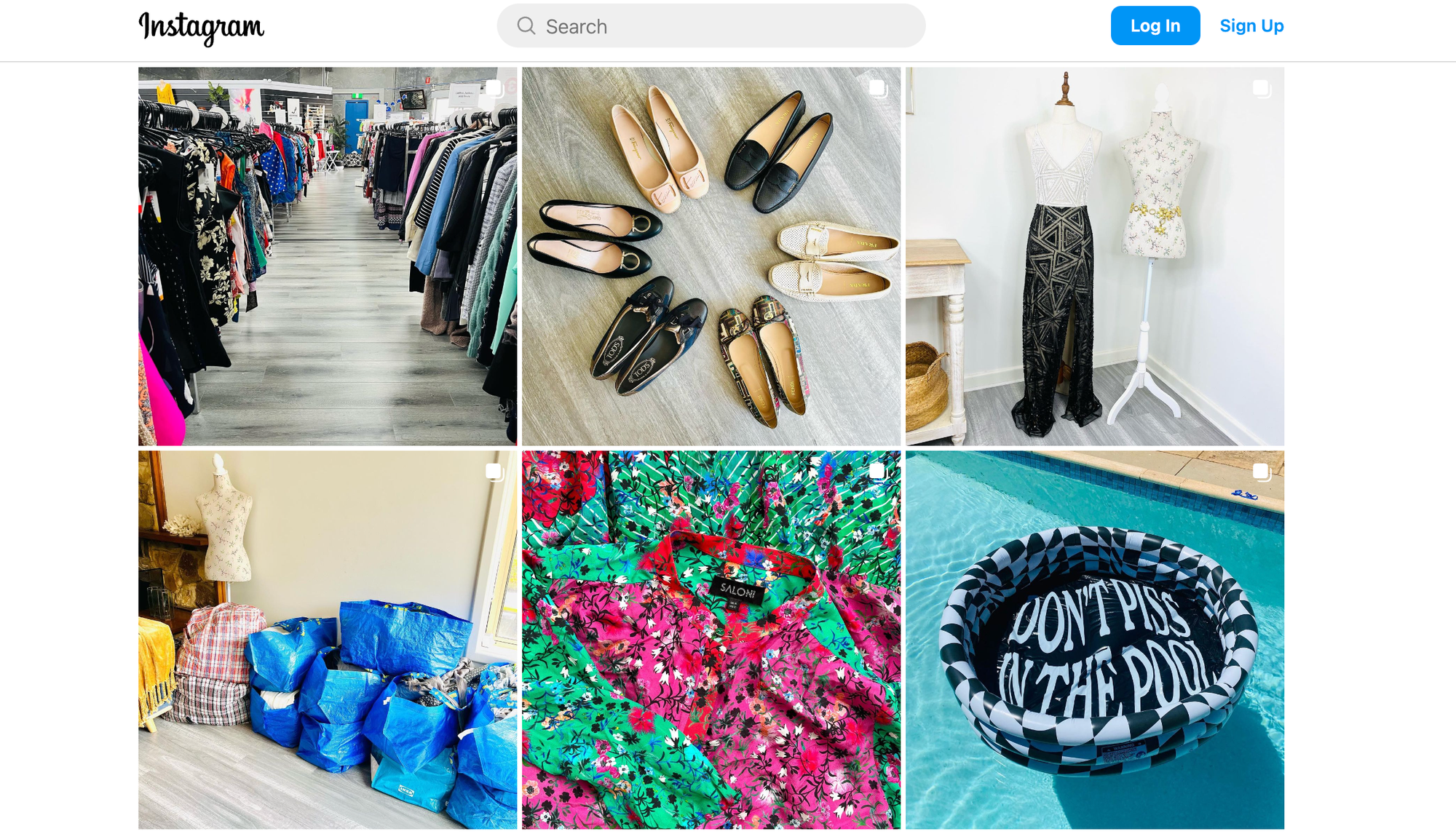
The market for thrifted clothes is booming, so many savvy resellers are cashing in by opening up boutiques online and in person that are stocked with clothing that they manually curate and source at profitable price points.
So, if you want to make money thrifting used clothes, the best way to go about this is to develop a sense of taste or lookbook based on what you see on social media, and to take the time to skim through stock at thrift stores like Goodwill or at garage sales. Not only can you find great pieces, in some cases, the prices can be so low that they could provide huge profit margins of well over 100%.
From there, you can build up an online presence that is catered towards a certain niche and then direct them to your online store which could either be a third-party platform like eBay, on your social media site, or your very own ecommerce site.
Just remember that as with any area of reselling, understanding and resonating with what the customer needs and wants is of utmost importance, so with thrifted clothing, you need to make sure your items and branding is aligned with what is currently hot and trending–even being a few months too late could mean slower sales.
Wondering where to sell your clothes online? We've reviewed the best platforms for every type of seller and business.
Can Reselling Clothes be a Profitable Business?
Many resellers at all levels of experience choose clothing as their primary focus because of all the reasons we previously mentioned, most notably the evergreen demand and chance of scoring high profit margins in the market of thrifting or in select hyped new streetwear.
However, not every clothing reseller ends up with a profitable business. Some common mistakes that beginners make include not knowing where to source profitable items at all or how to find them consistently, not understanding trends or demand, or not knowing how to find buyers effectively.
Not everyone starts as a profitable clothing reseller, but if you take the time to learn and grow, you can become profitable over time.
To get you closer to that goal, here’s a step-by-step guide on how to profitably resell clothes the right way:
How to Make Money Reselling Clothes in 7 Easy Steps
1. Choose a niche
While clothing is so broad that you can go the generalist route and resell all styles and types of clothing in various conditions, you’ll have a much easier time establishing consistent profit and building a loyal audience if you pick a niche.
Picking your niche
The best niche to consider is one that you already have a current interest or passion for, as this will allow you to resonate with your customer authentically, giving you a huge edge against competition.
Ideally, your interest will overlap with a currently trending market, but even if it’s not an exact fit, you can get curious and learn more about what people are buying simply by looking at what is being promoted on social media and what the top sellers are on popular platforms.
The best niches of clothes to resell:
- 90’s and Y2K apparel
- Trending older vintage clothes
- Modern streetwear
- High fashion
- Rare and collectible band tees
- Lightly used brand name
- Athletic wear
If you want a clothing-related niche that you can build a reselling business from, you should also consider flipping shoes–here’s a full guide on how to get started.
2. Source your clothes
Successful clothing reselling starts with a solid sourcing strategy from the right place. Here are some of the best:
Where to source clothing to resell
- Thrift stores
As we mentioned previously, thrifting is perhaps the best opportunity in clothing reselling as it is both currently trending and can produce high profit margins. Head over to donation stores like Goodwill and Salvation Army and go digging if you want the potential for sky-high profit margins, but you can also go to pre-curated thrift stores like Buffalo Exchange and see if the items go for even more online. - Garage and Estate sales
Another great place to source clothing of all kinds is at garage and estate sales. The best two times to go are at the very beginning, where you can get first dibs on the best items, and at the very end, when you can negotiate the best prices and often get extras thrown in for free. - Wholesale lots
Buying clothes in bulk might require a higher budget, but it also presents the opportunity for higher profits per item. Understand that with buying wholesale, you might not be able to inspect each item before buying, so do your best to calculate profitability and make sure it’s on the higher side before taking on the risk of buying a full lot that will almost inevitably include items that are worth little to nothing. However, incorporating wholesalers as a reseller is the secret sauce for many that have a thriving business. For a deep dive on this topic, read: How to Find Wholesalers as a Reseller - Clearance racks
An evergreen opportunity in resale in any realm, including clothing, is that of retail arbitrage, which is basically a fancy way of referencing the ability to profit from low prices in one marketplaces by selling for a higher place on another.
Be sure to browse the clearance racks in stores that stock brand names, keeping an eye out for deep discounts on trending items–it’s almost guaranteed that these are going for a higher price somewhere else, so it’s just a matter of buying them on clearance and selling them where people are still paying at or close to retail price. - Local marketplaces
Don’t overlook local sources for clothing inventory, as these have the opportunity to be the unique edge you have against other sellers online. Facebook Marketplace, Craigslist, and local buy/sell groups can be goldmines for finding individual items or even bulk lots at great prices.
The added advantage of using local marketplaces is that you can inspect in person, which reduces the risk of buying damaged or misrepresented goods. Additionally, you can hone your negotiation skills and develop relationships with sellers who might become a consistent source of stock. - Online platforms
While you’ll very likely use these exact same sites to sell your clothes, due to the nature of the free market and price ranges, these platforms can double as great sources for undervalued items.
Set up notifications for specific items below a certain price threshold so you can be the first to scoop up incredible deals. You can also look for quality items whose only flaw are lackluster photos or a short description that might discourage the ordinary buyer.
3. Prepare your inventory
Once you’ve sourced your items, you will have to prepare them properly if you want to fetch the highest prices. Here are some tips for getting your clothing ready like a pro:
Clean and repair
One of the most consistent methods to justify higher prices for the clothing you bought is to buy dirty or damaged clothing that you take the time to clean and repair. Obviously, there’s a line that you shouldn’t cross with clothes that might be beyond salvaging, but dealing with small flaws like holes or removable stains that you can repair to the point of not being noticeable can be well worth the effort.
Make everything presentable
People buy based on how the clothing looks at the moment you take the picture of it, so make sure that the items are wrinkle free, and you can consider placing the item on a mannequin or even yourself if the marketplace calls for it (Poshmark often features pictures of sellers wearing their clothing for a fit preview). Additionally, make sure the clothing is free of pet hair or odors.
Organize
While this might not be an issue in the beginning, as your business and inventory scales, keeping your clothing organized will make for easier fulfillment, so it’s better to build this habit early on when it’s not as necessary than scrambling to figure out how or where to organize when it becomes essential.
4. Choose a place to sell them
The most important part of getting your clothing sold is picking a platform that you can sell it on.
You’ll want to pick a platform that has the following qualities:
- Maximum exposure
The more people who see your offerings, the higher chance you’ll be able to move inventory quickly, which is essential for optimal cash flow for your business. Pick popular platforms where your item is likely to be seen by as many people as possible. - Catered to your target audience
In some cases, you’re better off getting less exposure to a more targeted audience that is more closely aligned with the inventory you have. For example, Vinted might not have the massive reach that eBay does, but you might be able to sell a vintage piece faster there with less views due to higher specific demand. - Profitable prices
Before listing on a platform, be sure to cross check other platforms for the same item to see which gives you the highest potential profit margin based on what prices the competition is setting. Always go for the platform that has the best combination between high prices and good exposure–you can always list on two platforms at once to increase your chances for getting the best price and selling quickly. - Good tools
Not all platforms are made equal. Make sure to check out what kind of tools and features a platform offers its sellers. Look for an easy-to-use dashboard, capabilities such as sending and receiving offers, and easy listing creation. A well-equipped platform will save you time and help you make data-driven decisions. - Reasonable fees
Lastly, you’ll want to pay attention to the fee structure of each platform. In general, around 10% is a fairly standard platform fee for most clothing items. Make sure that the features justify the fees that are being charged–sometimes it’s worth paying a higher fee for better exposure and higher sale prices.
Popular options include EBay, Poshmark and Mercari. We’ll get into the specifics of each of these later.
5. Perfect your listing
When it comes to making your listing, you will want to do the best job you can to make it both eye-catching and informative so that you convert a viewer into a buyer.
Here’s a quick checklist of what makes a good listing:
- Good photos
Like it or not, buyers are incredibly visual, so they’ll often make purchase decisions primarily based on how good a photo is of a product. Do your best to take high-quality photographs with good lighting, showcasing the item and its exact condition from every useful angle. Attempt to make your listing photos the closest your buyer will get to inspecting the item in person after seeing a main photo that showcases it in the best light. - Detailed description
When it comes to making a description, be as thorough as possible so as to avoid any unnecessary questions that add friction to the buying process. Additionally, you have to remember to be as honest as possible with any potential flaws in addition to exact measurements and other expectations to raise customer satisfaction and reduce return rate. - Competitive pricing
Finally, your listing needs to be well priced. If possible, pull up recent historic data of what prices your item has sold for, and price competitively so that your item sells quickly, undercutting other sellers if your profit margin allows. Remember that speed and getting a slightly lower price is almost always better than waiting much longer for a slightly higher price as your money will compound with your ability to reinvest more quickly if you move inventory fast.
6. Sell and fulfill
A good listing is bound to get a sale, but this transaction is simply the start of the customer journey.
You’ll need to follow through and fulfill the item in an efficient and memorable manner, providing a great customer experience along the way so that your customer will want to come back for more. A few pro tips to keep in mind when fulfilling include the following:
- Go above and beyond with customer service
You should view each and every customer not just as a single sale, but as someone who might come back to buy from you again. Respond to any inquiries promptly and professionally, and be honest, friendly and straightforward with everything. Accommodate any and all reasonable requests, and follow through with your word.
These are basic principles of good customer service, and you might be surprised how much this will make you stand out based on how many sellers don’t do this. - Package securely
Invest in quality packing materials to make sure your items arrive in perfect condition as expected or better. Remember that your packaging is the first impression that the customer has of you, so do it right– a sloppy packaging job could mean not just a damaged item but also harm to any current or future relationship with the customer. - Efficient and timely shipping
People want things faster than ever today, and this is especially true with clothing items. Try to ship out your item the same day it is sold if possible, and use the fastest possible method that still allows you profit. - Follow up
After the sale, consider sending a thank you as a follow up, and don’t forget to ask for a review if a customer doesn’t leave one within a few days. There’s no need to be overly pushy, but also customers often forget to leave reviews unless they’re reminded to. If you did a good job with all of the customer service and the buyer is happy with the item you sold them, you’ll very likely get a good review which is essential to establishing and maintaining a good seller reputation.
7. Create a consistent and repeatable process
After you’ve followed through each of these steps with your first sale, you’ll need to do it over and over with each sale, treating each one as special as your very first sale.
Over time, you’ll develop a good process that will give you the foundation to scale.
Here are some examples of methodologies and systems you can use to professionally go about running your clothing resale business:
- Inventory management
Staying organized in a spreadsheet might seem like overkill at first, but your future self will thank you once you’re scaling. Develop a system to track your inventory, including relevant data like the price, location and date of both purchases and sales. This spreadsheet or inventory management software will also come in handy during tax season. - Sourcing and listing schedules
While you can source and list whenever you want, you’re best off batching these activities. You’ll have more of an ability to batch your listing schedules compared to sourcing which might require you to act on time-bound opportunities, but regardless, try to block out time to do as much as you can within a dedicated period so you can efficiently scale. - Create SOPs
Standard Operating Procedures, or SOPs, are the secret weapon of any business owner who is looking to streamline their workflow with a clear and repeatable process. Additionally, SOPs will come in handy when it’s time to bring on staff that will help you run your operation. - Continuous education
The most important component to a lasting online business that is on track to scale is that the business and its offerings remain relevant. Stay up to date on the latest market trends, opportunities, tools, and winning strategies that other resellers are using to keep their businesses healthy.
Consider joining a dedicated private community that will keep you accountable in addition to giving you the latest in terms of actionable knowledge in the field. Check out the best online reselling communities right here.
What are the Best Clothes Reselling Apps?
Here are the top 6 marketplaces that have dedicated seller-friendly apps that you can use to move your clothes. In the beginning, consider listing your items on as many apps as possible so you can get an idea of which apps are best for your inventory. Just be sure to take down items everywhere as soon as they’re sold somewhere, or you can also consider using software such as Vendoo which helps you manage the listing of a single item across different marketplaces.
You should eventually cut down to just a few apps for easier operations that will allow you to efficiently scale:
EBay

Best for: Selling used, brand name clothing or trending pieces with no platform fees
When it comes to picking a top marketplace to resell clothes in any category and condition, it’s hard to beat eBay. As one of the most established ecommerce brands in existence, it attracts many millions of buyers who favor its variety and popularity with reputable sellers. It’s also completely free to sign up for a basic seller account.
EBay is also fully loaded when it comes to tools and functionality. It has a powerful dashboard that allows you to easily view and manage listings. You’ll also be able to see data surrounding average sales prices of an item which give you a realistic suggested price range in addition to being able to see real historic sales numbers and competing sellers.
Additionally, as of April 2024, eBay eliminated seller fees associated with used clothing, which is yet another reason why it’s a top choice for those looking to get into clothes reselling.
Facebook Marketplace
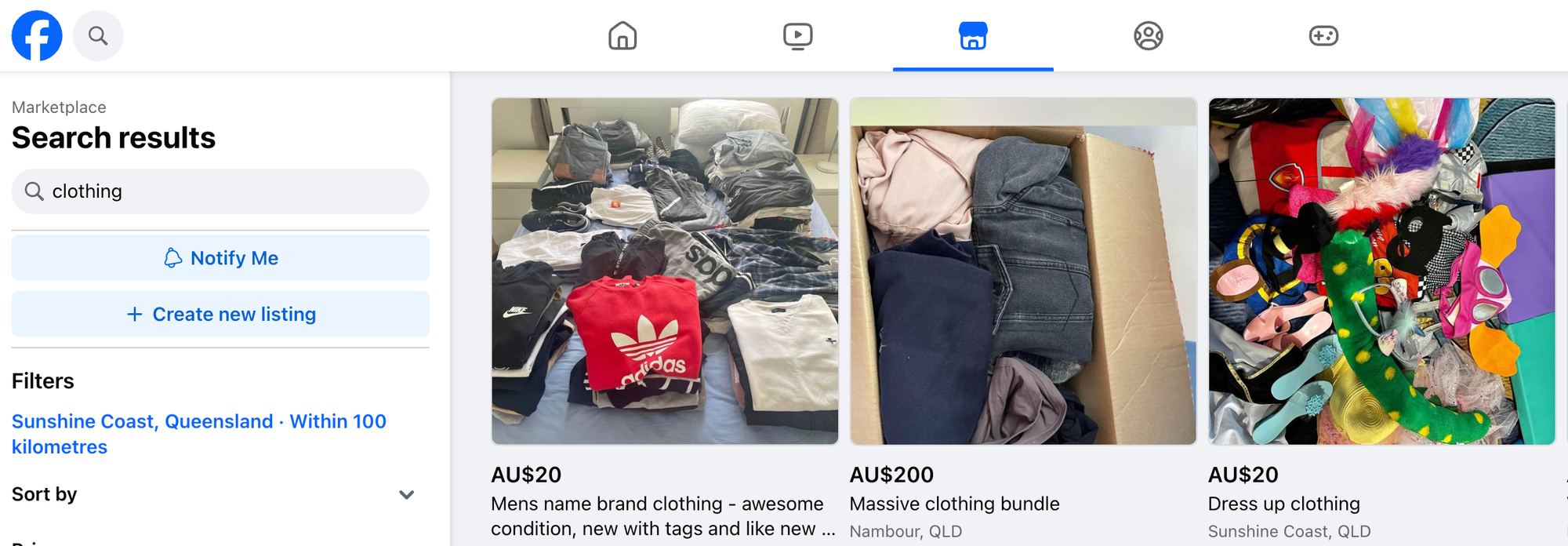
Best for: Local sales of everyday wear and honing negotiation skills
Facebook marketplace continues to surge in popularity in recent years, and it’s become a go-to platform for local buying and selling of clothing. With such a massive user base, you’ll be able to find an audience for basically every niche, however, popular, everyday wear brands and clothing styles will have the most active audience. An added benefit of using Facebook Marketplace for both buyers and sellers is the ability to view seller ratings and profiles which makes transactions more personal and trust-driven.
Facebook marketplace also supports shipping which grants you wider reach, with a competitive 5% selling fee for each shipped item. It’s still best to use the platform mostly for local sales as there is more trust involved and no fees are involved for both parties.
Poshmark
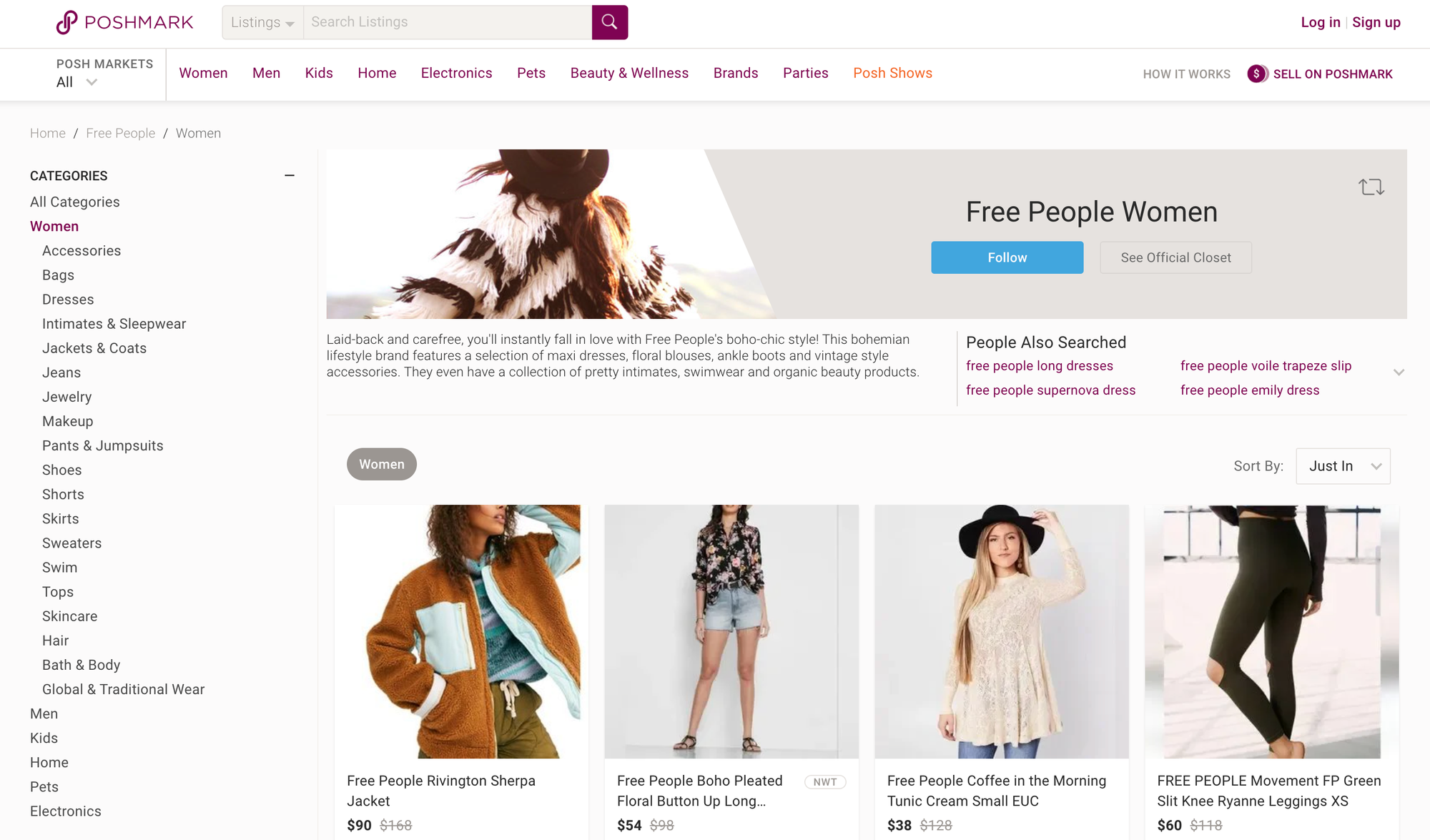
Best for: Athletic and budget-friendly pieces and building an audience that follows your style
Poshmark is a clothes reselling platform that is mostly catered towards women and one of its most noteworthy characteristics is its social aspect. Sellers get likes and engagement on their listings, can gain followers, and share other listings. As with other social media platforms, the more popular you get, the higher your listings are on the feed, which can make for great business for those that enjoy the process of engaging with and growing a following.
Another unique feature of Poshmark are its livestreams known as Posh Parties which can be a great way to offload your closet when it’s aligned with a certain theme or style that is currently in demand.
In terms of fees, Poshmark is on the higher end: the platform takes a flat 20% on sales over $15, and a flat fee of $2.95 for sales under $15. However, they make up for it with free prepaid shipping labels and the inclusion of sales tax and free credit card processing.
Vinted
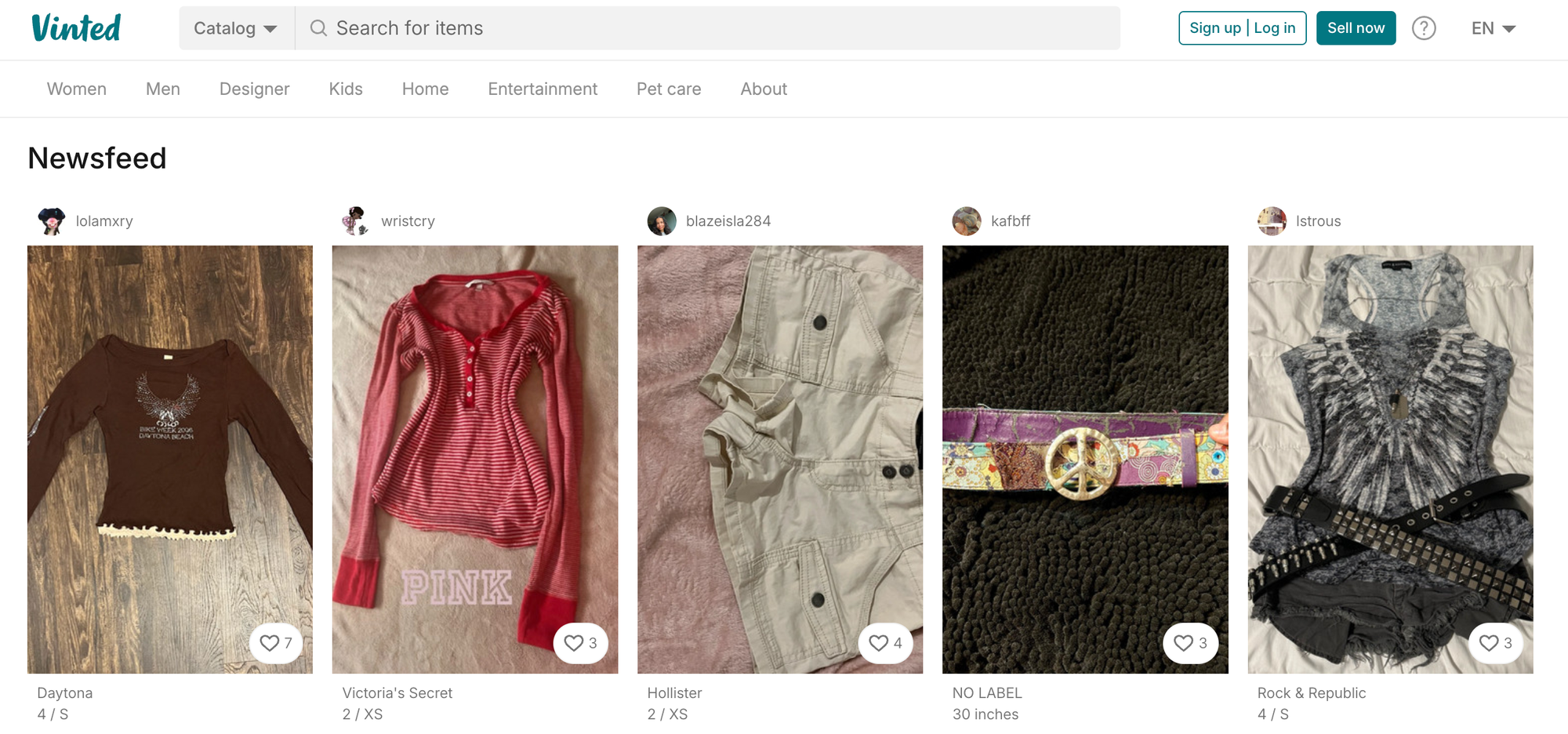
Best for: Curated vintage clothing with no seller fees
While it started as a small company for selling used clothing items in Lithuania, Vinted has expanded immensely in the past years with its reach now covering most of Europe and the US. Its main focus is promoting eco-conscious consumerism and sustainability through second-hand fashion.
It’s still gaining traction in the US, but it should continue to do so based on its high number of attractive qualities–a main draw is 0 fees for sellers.
On par with its name, Vinted is most popular for pre-loved vintage wear in just about any price range, and while it might not get the high traffic of other platforms, you have the potential to get better prices and less competition as it is a growing platform with a strong brand and mission.
Mercari
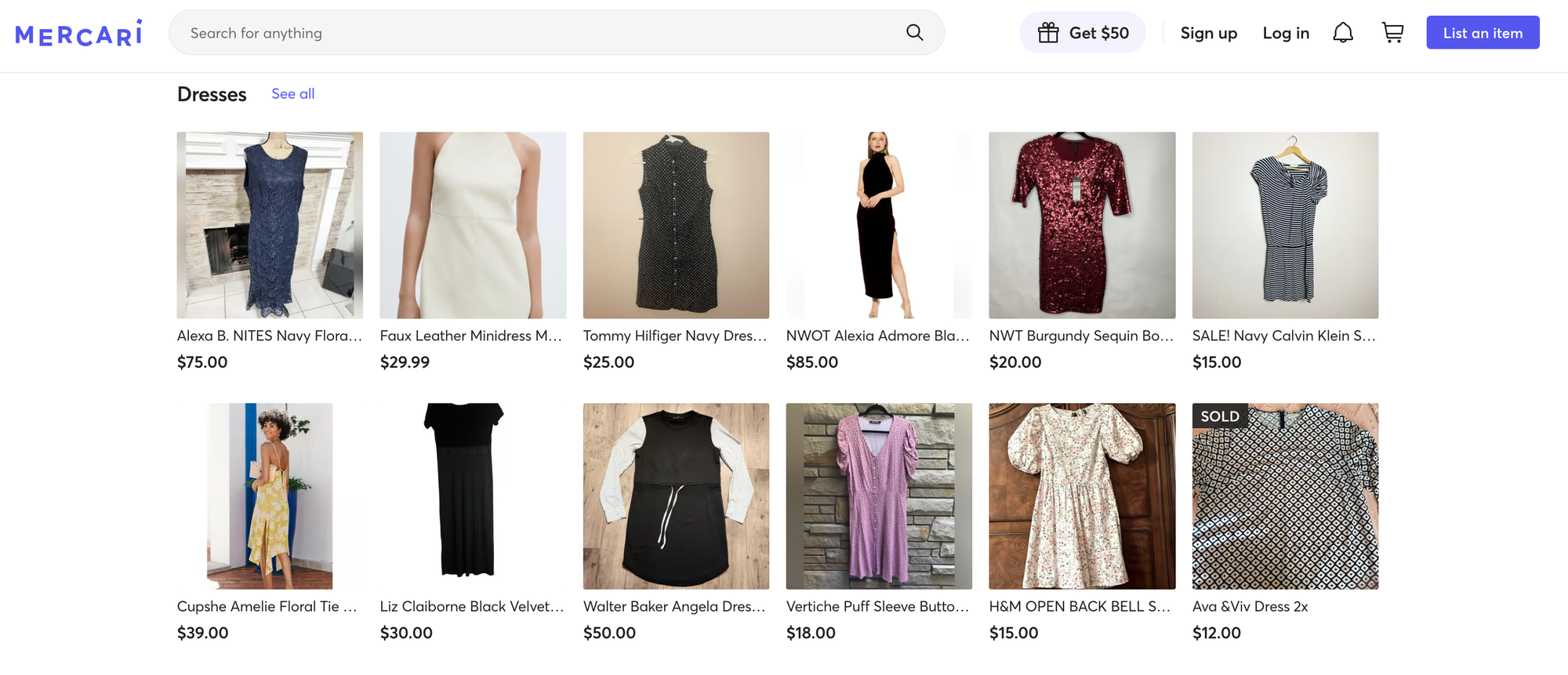
Best for: Mid range fashion and accessories with the ability to bundle items
One clothing platform that has also made a name for itself in recent times is Mercari, which is known for its pleasant user-friendly interface that supports the sales of items in several categories, a main one being clothing.
Its features include a smart pricing tool which allows sellers to optimize prices based on market data in addition to the ability to privately send offers to interested buyers. On Mercari, you can also bundle items, which gives both you and your buyer a discount on shipping. The most popular clothes sold on Mercari lie somewhere between budget and more expensive fashion.
The listing process is straightforward, and there is no fee to list an item or to sign up as a new seller. Once you make a sale, you pay a flat 10% fee in addition to an industry-standard 2.9% + $0.30 processing fee.
Grailed
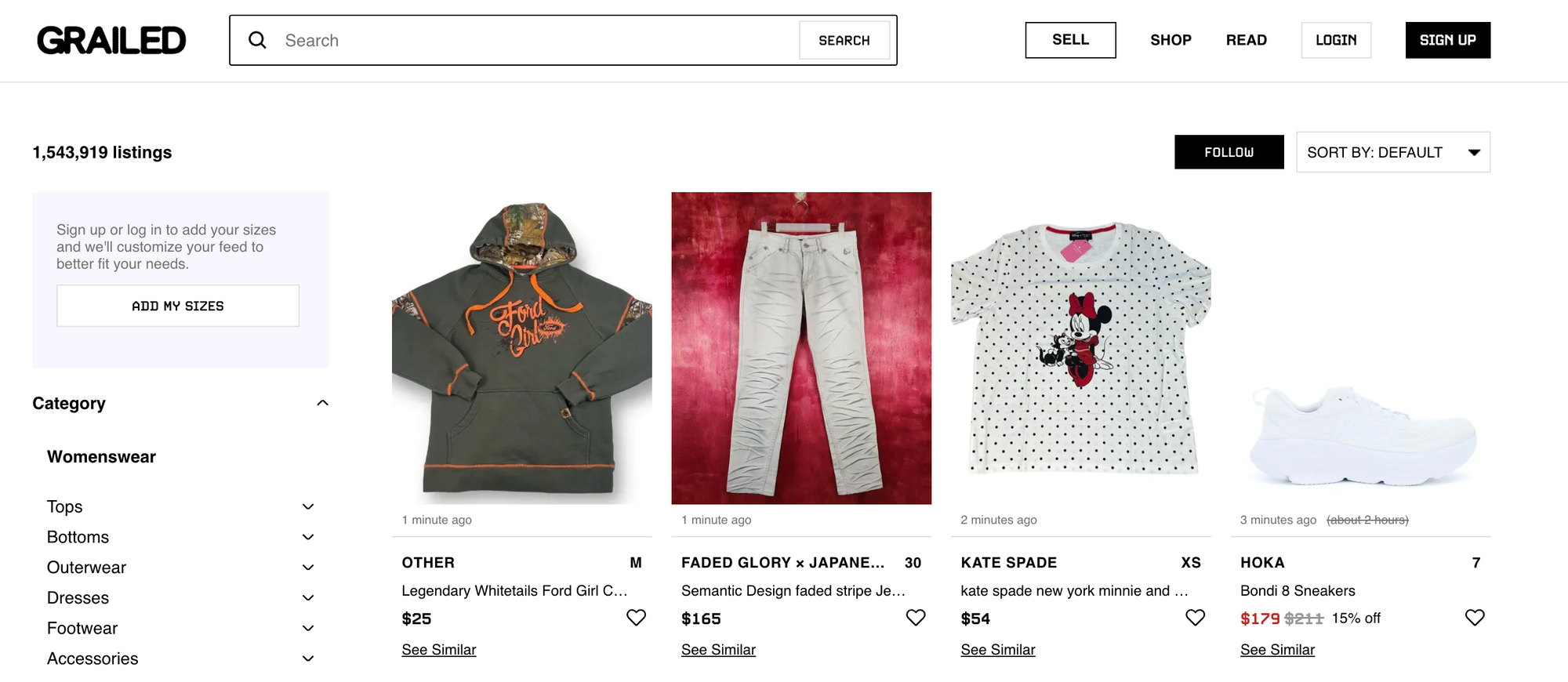
Best for: Hyped streetwear items and accessories or rare vintage
One high-ticket category of clothing that has the potential to be incredibly lucrative is that of hyped streetwear. However, those who will pay for designers are picky, not just with brands and styles but also with the chosen platform.
Grailed is the go-to marketplace for designer wear at any price, so if you have a rare or currently trending piece of streetwear, your audience is most likely there.
The platform focuses largely on trust and curation, so it’s important to establish a positive reputation quickly and to showcase your style so you can gain a loyal audience.
Grailed charges a seller fee of 9% of the total sales price in addition to a 3.49% + $0.49 payment processing fee.
How Much Money Can You Make Reselling Clothes?
When it comes to your earning potential, a clothes reselling business can vary quite a bit. Reselling in general is an excellent side hustle, and a focus on clothing is a great starting point. If you approach the business with this mindset, earning a few hundred to $1,000 per month is a realistic first goal.
However, for those with the hunger and dedication, it’s possible to scale to a full-time reseller who makes a living completely off of flipping clothes.
Top clothing resellers can make $5,000 or even $10,000 per month or more if they master a high-demand niche such as vintage designer, rare tees, hot fashion pieces or hyped streetwear.
If you want to be a top earner, you also need to develop a consistent and efficient sourcing strategy and match your inventory to the platform where it will sell the best.
Most importantly, the top percentage of clothing resellers are constantly educating themselves and working together with a team, including mentorship and guidance, which is something that can be achieved by joining a private community.
The Secret to Reselling Clothes Successfully: Joining the Community
It’s pretty much impossible to succeed in business completely on your own, and everyone who has “made it" will tell you that it was the power of team and community that got them to where they are today.
Once you’ve settled on your clothing niche, browse online for dedicated groups surrounding it. You’ll find them for free on places like Reddit or Facebook groups, and once you’re in, don’t be afraid to interact and ask questions in addition to browsing the existing advice from others.
These reselling communities can provide incredible free resources like authentication or legit checks for rare and commonly counterfeited items, unique strategies that other people are using, and the opportunity to network.
While many of these communities are out there for free, you’ll have to do a lot of digging and curating on your own to assemble a single go-to resource for your needs–this is why some choose to go straight to the source of an expert-led private community.
Find Reselling Communities and Advice on Whop
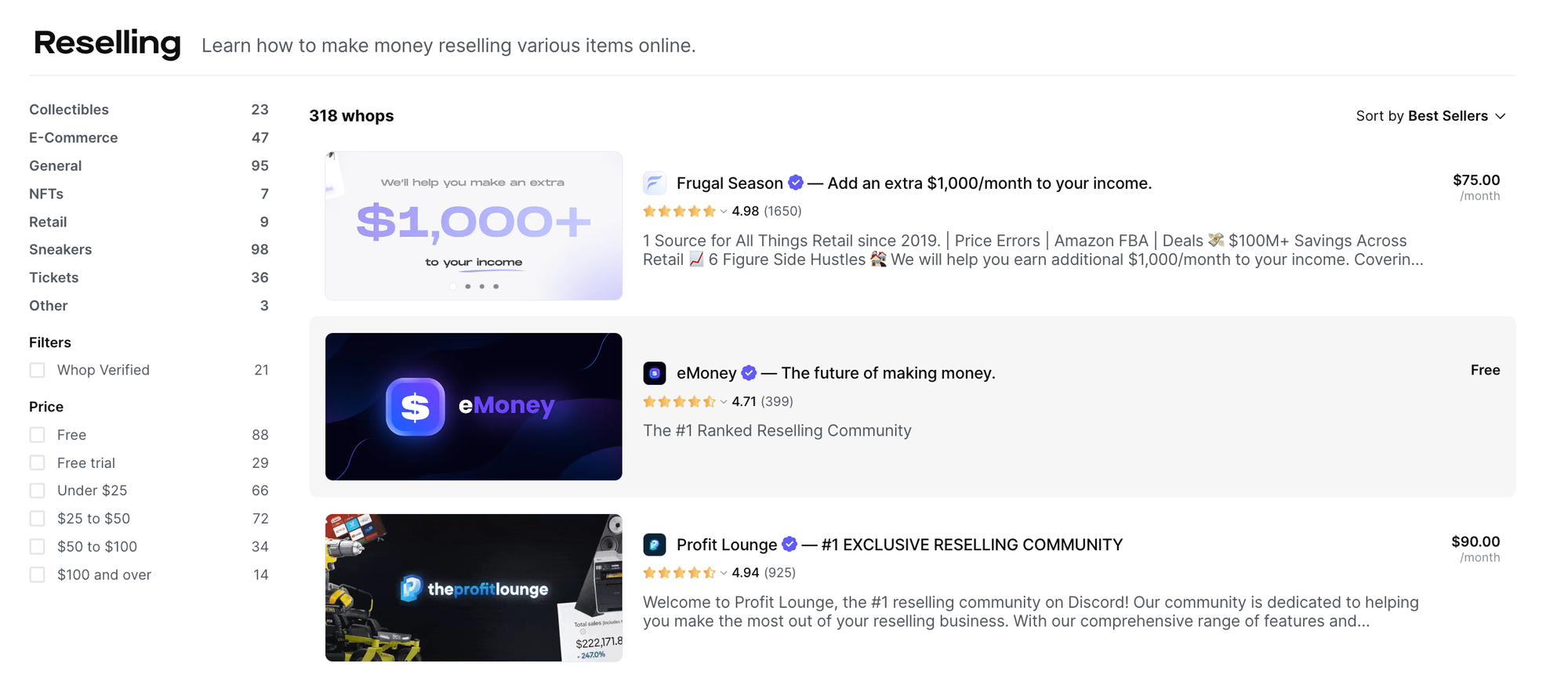
If you want a comprehensive solution for all of your reselling needs from clothes to sneakers and tickets and everything in between, check out Whop.
In Whop’s thriving marketplace of top-notch offerings, you’ll find a curated collection of the best resources including private communities, courses and helpful tools and software that will give you an incredible edge against competition and the inspiration and motivation to scale. Whop is home to hundreds of successful resellers who eagerly share their advice and best finds with their community members.
Equipped with these tools and resources, you’ll have everything you need to lay the foundation for you to become the successful business owner that you know you deserve to be.


